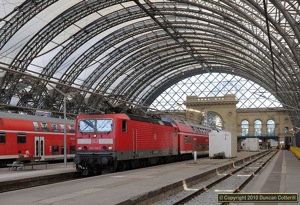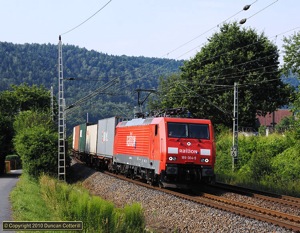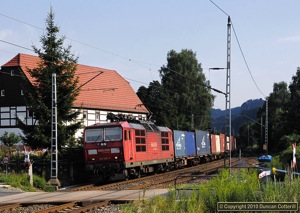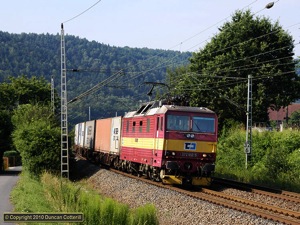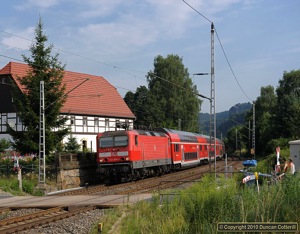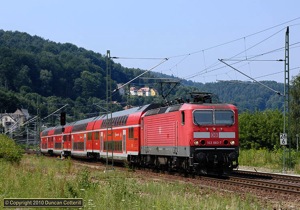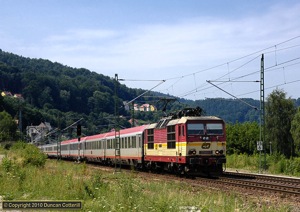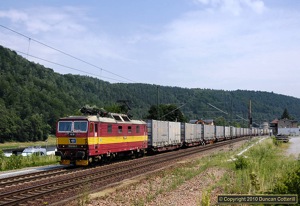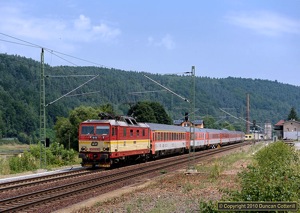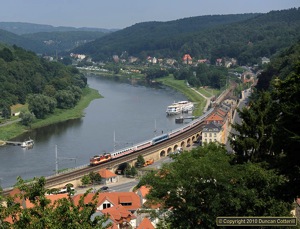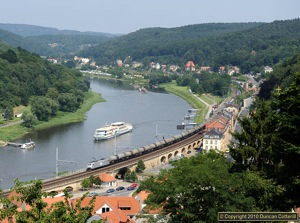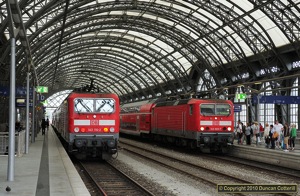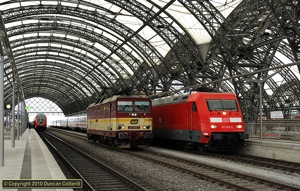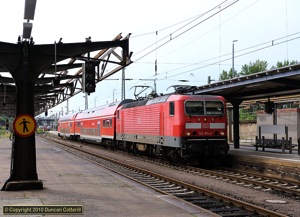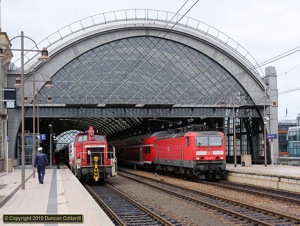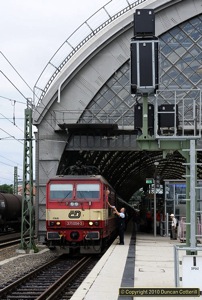Dresden and the Elbe Valley
21 - 25 July 2010
Report by Duncan Cotterill
Introduction
This report covers a short trip to the Dresden area in the south-eastern corner of what used to be East Germany. The city of Dresden is an attraction in itself but it was the line along the scenic Elbe Valley that prompted my visit. This route is busy with loco hauled passenger and heavy freight traffic and the home to a type of electric loco that is difficult to find elsewhere, DB Class 180, also known as CD Class 372.
A list of sightings can be found here.
Passenger Services
For a city of its size and importance, Dresden is very poorly served by long distance passenger services. ICEs depart hourly to Frankfurt(Main) via Leipzig and EuroCity trains from Praha to Berlin call every two hours or so but that’s about it! Most of the Praha - Berlin trains are hauled to Dresden by CD Class 371 electrics which hand over to DB Class 101s for the run north. One early morning turn, on trains EN476 and EN459, takes an ÖBB Class 1216 through the Czech Republic to Dresden and then back to Praha, while a DB Class 120 is booked to arrive from Berlin on train IC2077 on Wednesday evening and return north on train IC2076 on Thursday morning. Trains EC175 and EC174 are booked for a DB Class 182 from Berlin to Dresden and return on Friday and Saturday.
S-Bahn services run at 30 minute intervals throughout the day and most regional services are fairly frequent as well. The vast majority of these trains are loco worked by Class 143s on double-deck push-pull sets. The loco is almost invariably at the east end of the train at Dresden Hbf. I did see a few workings with the sets the other way round but no more than 1 or 2 a day. Trains to/from Leipzig and on S-Bahn line 1 (Meißen-Triebischtal - Dresden Hbf - Schöna) are usually formed of four coaches while two, or occasionally three, coach sets are the norm elsewhere. The main exceptions to the “143s on everything” rule are services on the unelectrified lines to the east, principally towards Görlitz and Zittau, which are worked by DMUs of Classes 612 and 642. RE services to Nürnberg are also worked by Class 612s despite the line being electrified as far as Reichenbach.
Freight Traffic
The line up the Elbe Valley from Dresden to Decin, a few km across the Czech border, is a busy freight route. Even on the Sunday, 12 freights were seen during a 4 hour trip from Heidenau to Decin and back. The line is the stamping ground of DB’s 15kV AC/3kV DC Class 180s and their Czech Class 372 counterparts. These classes can be seen west of Dresden and south of Decin but spend most of their time shuttling between these two points. DB Class 189s are now certified to run into the Czech Republic but very few were seen.
Locos from several independent operators were also seen. ITL seemed to be the biggest player by far with locos of classes 185, 186 and 189 all working east of Dresden. MRCE 185s, a Captrain 186, a pair of RBH 143s and an MTEG 189 also appeared but far less frequently than the ITL locos. Czech and German independents often seem to exchange trains either at Bad Schandau or Pirna, bringing Czech Class 753.7 diesels owned by Unipetrol and OKDD onto German territory.
Photography
Dresden Hbf is a magnificent station but is extremely difficult to photograph. Most regional services use the terminal platforms in the middle of the station so the locos are at the wrong end for the classic shots of trains emerging from under the overall roof. The area outside the roof is in a dilapidated state and mostly cordoned off anyway for safety reasons. Long distance services use the through platforms at either side of the station, invariably platform 1 for ECs from Berlin to Praha, platform 2 for ICEs and Platform 17 for ECs from Praha to Berlin. Each of these platforms is poor for photography. The east ends of platforms 3 and 18 are the only ones where everything is potentially right and nothing uses the east end of platform 3. That only leaves platform 18, which is fortunately one of the busiest as it’s used by eastbound trains on S-Bahn lines 1 and 2. The overall roof has recently been rebuilt and the inside is lined with translucent white material creating a very diffuse lighting effect that looks pretty flat even in bright sunshine. There are none of the patches of light and shade that make photographing in other stations with overall roofs so rewarding.
Dresden-Neustadt also has an overall roof, largely in unrebuilt condition but again the platforms at the south end of the station are derelict or in the course of being rebuilt and are not accessible. It is possible to get shots of trains emerging from the north end of the roof but they invariably run with the driving trailer leading.
My main reason for visiting Dresden was to get some photographs in the Elbe Valley, between Dresden and the Czech border. East of Pirna, the line runs along the south bank of the river, between steep wooded hills with some impressive rock outcrops, attractive villages and even the occasional castle. On the river the paddle steamers add to the interest although getting one in a train photo would require a lot of luck. Although much of the lineside is overgrown, it wasn’t too difficult to find a few really attractive locations around Kurort Rathen and Königstein and more potential spots were noted during my visit.
A list of sightings can be found here.
Exploration
Unfortunately, I got less than one day in the Elbe valley before the weather caved in. Thursday afternoon’s thunderstorms were followed by cloudy skies and rain on Friday, Saturday and most of Sunday. The sun only broke through again when I got back to Dresden Airport for the flight home. With no prospect of sunshine on either Friday or Saturday, I travelled around looking for potential photo positions on lines that might have some freight traffic. My trip on Friday took me out past the main Dresden yard at Friedrichstadt where a good number of class 140s and 155s were on shed alongside more modern electrics. A few class 140s were on shed at Hoyerswerda as well. Passenger trains seen on electified lines were all worked by 143s on push-pull sets, only one of which wasn’t double-deck. My destination for the day was the Hoyerswerda - Horka line, a single track, unelectrified route used by freight traffic to and from Poland. Two diesel hauled freights were seen during the two hours I was on the line, both hauled by DB Class 233s. Scenically, the line wasn’t very interesting but there were a few reasonable positions, particularly around the stations, many of which still have semaphore signals and other steam age infrastructure. Surprisingly many stations on the line appeared to have signs in both German and Polish. It turns out that the second language wasn’t Polish but Sorbian, a Slavic language spoken by a minority group in the area - thanks to Bob Thompson for this information.
After a couple of hours, I continued to Görlitz, a station with a superb overall roof but, so far as I could tell, no booked loco hauled passenger trains. Local passengers around Görlitz, including those to Hoyerswerda, are operated by ODEG using DMUs. Trains to Dresden are still operated by DB using DMUs of classes 612 and 642 and I took one of the latter back to the city, passing a freight hauled by an ITL class 285 at Bischofswerda.
Saturday’s trip took me northwest of Dresden to Riesa and Elsterwerda. Riesa is on the Dresden - Leipzig main line, a busy route with hourly RegioExpresses and ICEs and plenty of freight. DB locos of classes 140, 145 and 155, an ITL 185, an MRCE 189 and an SBBC 482 were seen on freights or running light. Apart from the ICEs, all passengers were 143s on double-deck push-pull sets. I travelled north from Riesa to Elsterwerda-Biehla before returning to Dresden. At Elsterwerda, a couple of Class 114s were seen on RE services to/from Stralsund via Berlin. During my 80 minute layover at Elsterwerda-Biehla, no less than four freights were seen, all eastbounds and all worked by independent operators. Two were hauled by MRCE class 189s, one by a Captrain 185 and one by a Hupac 182. Apart from the 114s, all passenger trains seen were 143 worked double-deck push-pulls.
There are two lines out of Dresden to the north and west. Most passenger trains use the northerly route via Dresden-Neustadt and Radebuel Ost to Coswig but a few take the southerly route via Dresden-Friedrichstadt and Cossebaude. There is currently a lot of engineering work on the northerly route with single track working in places. The main Dresden freight yard is at Friedrichstadt and most freights use the southerly route. Beyond Coswig there are also two lines to Großenhain on the route towards Elsterwerda and Berlin but the easterly route is currently closed for modernisation and the construction of a connecting chord to the Dresden - Leipzig line.
On Sunday I returned to Elbe Valley and travelled to Decin and back. The local service between Bad Schandau and Decin is operated by CD using Class 810 4-wheel railbuses during the week but it’s loco hauled at weekends. There have been reports of the train being top’n’tailed by a Class 371 electric and a Class 750 diesel but the electric was working on its own when I travelled, running round at both ends of the trip. The train was formed of four CD couchette coaches!
Getting Around
Travel on public transport around Dresden is very easy. There are a number of ticket options covering local rail, bus, tram and some ferry travel. The local passenger transport authority VVO (Verkehrsverbund Oberelbe) covers an area from the Czech border at Schöna to Arnsdorf, Hoyerswerda, Elsterwerda, Riesa, Nossen and Klingenberg-Colmnitz. A day ticket costs €12 and can be used all day, including the rush hours. For €15 there’s an Elbe-Labe ticket that covers travel in the VVO area and adjacent parts of the Czech Republic. For the trip to Hoyerswerda and Görlitz a day ticket for the ZVON area was also necessary. The VVO and ZVON areas overlap around Hoyerswerda but not on the Görlitz - Dresden line so an ordinary ticket was required to bridge the gap between Großharthau and Arnsdorf and was bought from the gripper on the train. DB also offers the Sachsen Ticket for €20 for one or €28 for up to five travellers. This covers a day’s travel on RE and RB services in all of Sachsen, Sachsen-Anhalt and Thüringen but isn’t valid before 09:00 on weekdays.
I stayed at the Hotel Reichskrone in Heidenau, on the south-east side of Dresden, and less than 10 minutes walk from Heidenau station on the Elbe Valley line.
Comments
This was my first real trip to the former East Germany since 1991 and I expected most of the old infrastructure to have been swept away long ago. Well, some of it has and some of it hasn’t. There were plenty of shiny new buildings or elegantly restored old ones in some places, like Dresden city centre. In other places everything seemed to have been abandoned and left to rot. The railways reflected this with some modernised stations that wouldn’t look out of place in the west and others where the buildings were boarded up and trees were growing between the rails of redundant loops and sidings, some of which still had working signals. Lineside vegetation has been allowed to run riot in most places on the lines I visited and finding spots clear enough for photography wasn’t easy.
Nevertheless, the Dresden area is well worth visiting for the Elbe Valley scenery and its unique motive power. The whole look of the area contrasts with western Germany, retaining far more of the Eastern Bloc feel than I had imagined. This in itself produces photo opportunities that aren’t available elsewhere. Despite the poor weather, yet again, I thoroughly enjoyed the trip and will certainly be going back.
